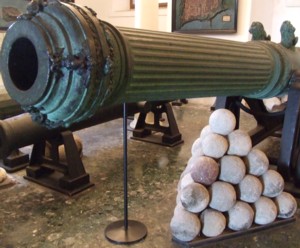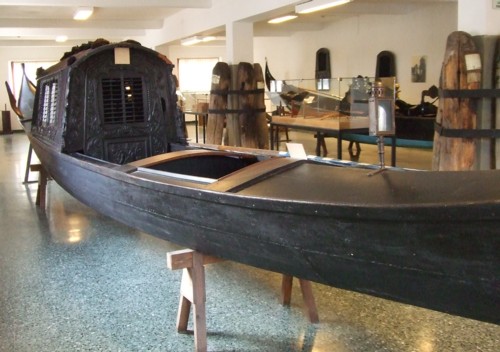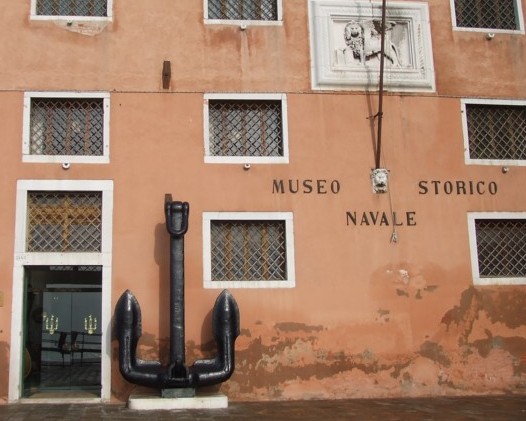The Museo Storico Navale is one of Venice’s less-visited museums, and is open only in the mornings. Situated in the Castello district, near the Arsenale, Venice’s historic shipyard, it is devoted to naval and nautical history, with exhibits covering five floors of the building. If the subject matter interests you, this rather old-fashioned museum is definitely worth a visit. If you’re here for a long visit and getting acquainted with the city, I’d recommend you pay a visit, if only to see the historic gondolas on display.
I found the museum extremely cold when I visited in winter, although there were more visitors than I’d expected. If you want to look around at all the exhibits, you should allow well over an hour. If you just want to see the gondolas, head upstairs to the third floor. Most of the labelling is in English as well as Italian.
The exhibition begins on the ground floor, where there is a marble monument by Antonio Canova to one of Venice’s most famous admirals, Angelo Emo. There are also some massive cannon, and many relief maps of overseas fortresses dating back as far as the sixteenth-century, when these had strategic military importance. Other more modern military exhibits include a torpedo, diving equipment and a folding boat as used on Austro-Hungarian submarines at the beginning of the twentieth century.

The museum has a very wide selection of objects and artefacts to do with nautical and Venetian history. There’s a display on boats through history, a vast collection of model ships, portraits of captains and admirals (including one painting that was damaged by a British grenade during WW2), ornamentations from Venetian vessels which illustrate how glamorous their fleet must have been on ceremonial occasions, models of the Roman ships found at the bottom of Lake Nemi in Lazio, a pennant flown from the aeroplane of Gabriele D’Annunzio and even a ‘Swedish’ floor covering that country’s maritime history (although without information in English). Perhaps the most interesting exhibits relating to Venetian history are the gondola display (more below) and a room featuring a model of the last Bucintoro, Venice’s golden state vessel, in which the Doge would set out for annual festival of La Sensa.
In the room dedicated to the gondola, specimens include Peggy Guggenheim’s gondola. The art-collecting heiress (founder of the Peggy Guggenheim Collection) was one of the last people to be ferried about in a private gondola; Venetians remember her riding down the Grand Canal with her little dogs. There are some photographs alongside of the gondola in use. The museum also displays a gondola with a felze, a cover over the seats which was ideal for intrigue (and the Venetian weather).

Admission is fairly cheap (reductions for Venice Card holders), and the money is donated to a naval orphanage. Opening hours are 8:45am-1:30pm (1pm on Saturdays) – do check the latest times online, though. The museum is closed on Sundays and public holidays. It is located close to the entrance to the Arsenale (vaporetto Arsenale or Giardini), and is set back from the lagoon-front promenade.
In the area
The western end of Venice is a good area to explore. The section of the Castello district around Via Garibaldi is very much a local area, where tourists are outnumbered by residents going about their business. It’s picturesque in a humble and old-fashioned way: smaller houses with their laundry hanging out to dry over calli and canals. There’s a greengrocers on a boat along Via Garibaldi, and plenty of normal-priced shops and bars. The cathedral island of San Pietro di Castello is a lovely quiet spot, while further to the west lie the public gardens (Giardini) where the Biennale is held. There are fantastic views of Venice from along the waterfront, and from the modern island of Sant’Elena which has a big park with benches.
> More Venice tourist attractions.
Useful external links
